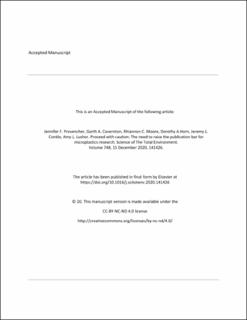| dc.contributor.author | Provencher, Jennifer F | |
| dc.contributor.author | Covernton, Garth A | |
| dc.contributor.author | Moore, Rhiannon C | |
| dc.contributor.author | Horn, Dorothy A | |
| dc.contributor.author | Conkle, Jeremy L | |
| dc.contributor.author | Lusher, Amy | |
| dc.date.accessioned | 2021-05-31T10:15:54Z | |
| dc.date.available | 2021-05-31T10:15:54Z | |
| dc.date.created | 2020-08-18T09:08:24Z | |
| dc.date.issued | 2020 | |
| dc.identifier.citation | Science of the Total Environment. 2020, 748, 141426. | en_US |
| dc.identifier.issn | 0048-9697 | |
| dc.identifier.uri | https://hdl.handle.net/11250/2757023 | |
| dc.description | This is an Accepted Manuscript. Embargo until December 12 2022. | en_US |
| dc.description.abstract | Plastic is a ubiquitous contaminant of the Anthropocene. The highly diverse nature of microplastic pollution means it is not a single contaminant, but a suite of chemicals that include a range of polymers, particle sizes, colors, morphologies, and associated contaminants. Microplastics research has rapidly expanded in recent years and has led to an overwhelming consideration in the peer-reviewed literature. While there have been multiple calls for standardization and harmonization of the research methods used to study microplastics in the environment, the complexities of this emerging field have led to an exploration of many methods and tools. While different research questions require different methods, making standardization often impractical, it remains import to harmonize the outputs of these various methodologies. We argue here that in addition to harmonized methods and quality assurance practices, journals, editors and reviewers must also be more proactive in ensuring that scientific papers have clear, repeatable methods, and contribute to a constructive and factual discourse on plastic pollution. This includes carefully considering the quality of the manuscript submissions and how they fit into the larger field of research. While comparability and reproducibility is critical in all fields, we argue that this is of utmost importance in microplastics research as policy around plastic pollution is being developed in real time alongside this evolving scientific field, necessitating the need for rigorous examination of the science being published. | en_US |
| dc.language.iso | eng | en_US |
| dc.publisher | Elsevier | en_US |
| dc.rights | Attribution-NonCommercial-NoDerivatives 4.0 Internasjonal | * |
| dc.rights.uri | http://creativecommons.org/licenses/by-nc-nd/4.0/deed.no | * |
| dc.title | Proceed with caution: The need to raise the publication bar for microplastics research | en_US |
| dc.type | Peer reviewed | en_US |
| dc.type | Journal article | en_US |
| dc.description.version | acceptedVersion | en_US |
| dc.source.pagenumber | 7 | en_US |
| dc.source.volume | 748 | en_US |
| dc.source.journal | Science of the Total Environment | en_US |
| dc.identifier.doi | 10.1016/j.scitotenv.2020.141426 | |
| dc.identifier.cristin | 1823744 | |
| dc.source.articlenumber | 141426 | en_US |
| cristin.ispublished | true | |
| cristin.fulltext | postprint | |
| cristin.qualitycode | 2 | |

